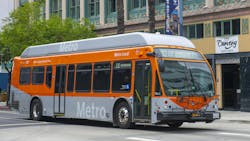L.A. Metro releases SetGo playbook to aid transit agencies in planning for major events
The Los Angeles County Metropolitan Transportation Authority (L.A. Metro) has released the Special Event Transportation – Guidance and Opportunities (SetGo) Playbook, a resource of best practices for transit agencies to handle an influx of passengers from large concerts, sporting events, political engagements and cultural events of any size.
Developed via L.A. Metro’s SetGo program, a national workshop series hosted with the American Public Transportation Association (APTA), the playbook utilizes the experience from major events hosted in the region. It draws on lessons from events like the Olympic and Paralympic Games (Atlanta 1996, Salt Lake 2002, London 2012), the Formula One Grand Prix hosted in Las Vegas, concert tours, major conventions and more.
While the playbook was mainly designed around major sporting events, the agency recognized that a majority of the same foundations of planning, delivery and after-action evaluation apply across a range of special event types and sizes.
A resource for mega-events
The SetGo Playbook, designed as a living document, identifies strategies for transit services for upcoming international-scale events in the U.S., including the FIFA World Cup 2026™, the Los Angeles 2028 Olympic and Paralympic Games and the Utah 2034 Olympic and Paralympic Winter Games. L.A. Metro says the plan was designed with evolution in mind, as agencies continue to test and refine approaches through the experience of future major events. The agency says it’s also intended to serve as guidance for elected officials and host communities to aid in the understanding of vital transit practices that could be deployed to make their events function smoothly.
“These major events give us an opportunity to showcase what our agencies can do when tested to our limits,” said L.A. Metro CEO and APTA Mega Events Task Force Co-Chair Stephanie Wiggins. “The SetGo Playbook isn’t just about the 2028 Games or the 2026 World Cup, it’s about ensuring every event we serve, whether global, regional or local, strengthens our ability to deliver universal mobility and excellent service for attendees and everyday riders by advancing the latest approaches in wayfinding, safety and security, crowd management and even ‘surprise and delight’.”
Key focus areas
The playbook organizes best practices across five subject areas.
- Purpose and need: Mission alignment, advocacy and coordination inside and outside the agency.
- Service plan: Demand forecasting, supplemental service, first/last mile strategies and speed and reliability.
- Safety and emergency management: Crowd management, security and emergency operations center planning.
- Customer experience: Accessibility, signage and wayfinding, integrated ticketing, ambassadors and “surprise and delight” activations.
- Agency-wide success strategies: Budgeting, workforce readiness, training, technology, contingency planning and after-action processes.
The playbook lays out guiding questions that transit agencies can use to gauge their readiness during planning, adjust methodology as events occur and to reflect on lessons learned in post-event reviews.
The agency says this approach may help other transit agencies implement best practices and align service with mission and long-term goals, as well as promoting consistency across the nation to ensure riders experience the same reliable, quality transit services no matter where in the country they end up.
“The SetGo Playbook reflects the power of partnership across our industry,” said APTA Chair Leanne Redden. “By pooling knowledge from agencies nationwide, we now have a shared framework that ensures we’re not starting from scratch as the U.S. prepares for a decade of global events, freeing agencies to focus on delivering safe, reliable and unforgettable customer experiences.”
WSP also contributed to the development of the playbook, adding its experience from global events to ensure that the playbook reflected both the needs of the U.S. transit agencies, but also existing international best practices.
